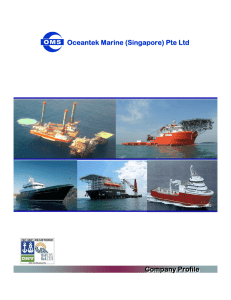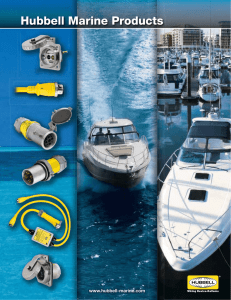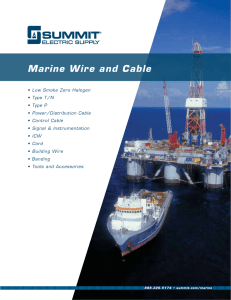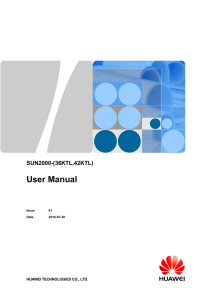Perspectives on Buying & Building Green Cables Nigel Bayliff Huawei Marine Networks
advertisement
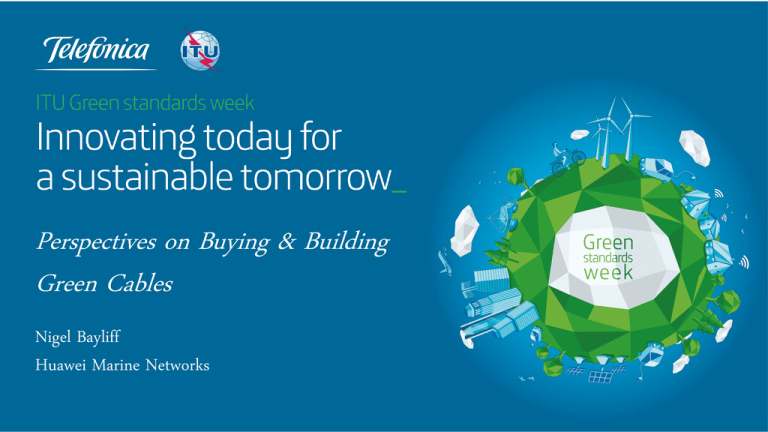
Perspectives on Buying & Building Green Cables Nigel Bayliff Huawei Marine Networks Perspective comes from . . . • • • • • • • Almost 30 years in the telecommunications field Most of this as a developer, owner and operator Since 2009, as a technology developer and vendor Experienced this industry sector from two sides Managed feast, restructuring and famine – all good Brought new subsea technology to market for HMN First titanium repeater & branching unit housing Perspective of HMN • • • • • • JV between Huawei and Global Marine (BT & C&W) Marine experience of Global Marine Optical Innovation of Huawei Technologies Opportunity to define, design and develop Driven by innovation but grounded in tradition Rapid prototyping and in-house qualification Innovative 6fp Repeater & 8fp Branching Unit Large Bandwidth and Wide Spans Up to 120km span distance, 1 ~ 6 fiber pairs 27nm/33nm broad gain bandwidth, supporting up to 160 channels per fiber pair Robust Mechanical Design; capable in a harsh marine environment Up to 8000m operating and recovery depth Reduced diameter sea case, can be plough buried directly by existing fleet Simplified design with redundant long-life lasers in a titanium pressure housing Failure rate < 6 FIT with 25 years design lifespan Page 4 Perspective on the goals of the JTF • • • • • • Macro Needs and Solutions are now well known Permit challenges could be overcome Strategy, Legal & Engineering papers are clear Sensor Design is showing convergence Vendors can develop, manufacture and deploy Design, Development and Deployment - all have a common issue “Show me the money” – Funding Shouldn’t ‘Industry’ absorb the cost? • • • • • • Commercial pressures – rise of free internet Significant price erosion for international carriers Cu/Fe rises causing margin squeeze for vendors Twin route LON-NYC 1999; close to $1bn > 2.4Tb 2012, Same Scope; conservatively $400M > 60Tb Cable developers want to minimise build costs “no pot of gold to fund science and research” Shouldn’t Industry absorb? – Carrier view Median Monthly 10 Gbps Lease Prices, Q4 2011-Q4 2012 Source: Telegeography Technical Challenges? • • • • • • Mechanical is easy to solve, connectivity harder Bringing data back on-shore is a key factor Loss of in-band capacity is a huge revenue threat Out-of-band could be ‘something for nothing’ Equivalent of Orderwire or SMS in C7 signaling Low impact will enhance chances of acceptance “Money is the key issue, again – what contribution” MOUNTIN G FACE CABLE ROUTE CABLE INPUT WITH GLASS/GLASS SEALING SCIENCE SEGMENTS “SCIENCESEGS” Maybe a Universal concept will work • • • • • • UJ™ consortium – majority of cable repair joints Core design is standard, with end-specific variants Vendors funded for collaboration and cooperation Universal fund? Suitable systems with options Standardised design – functional specification Proprietary mechanicals and data-relay If I were developing an oceanic system today . . I would . . . “Route for Revenue” – capture major traffic flows “Divert to Developing” – pass under-served countries “Branch for Oil&Gas” – near-continent fields & assets “Host the science” – funded sensors included Projects may already be happening, but this is what I believe will be needed to prove the business model Where is some of the money? “It is good to be green & good to be seen” • Philanthropists? – regional development funds • World Bank –funds for inter-regional activities • Development Banks – life-saving, green project • Green credentials attractive – Oil & Gas companies • Need to study these potential sources formally and build a ‘desire to fund’ from this community Challenge for the JTF & Community • • • • Search out the funds and potential investors Coordinate and collaborate for a universal solution Continue to raise awareness and publicise Green credentials attractive – seek Oil & Gas companies “A small group of thoughtful people could change the world. Indeed, it's the only thing that ever has.” – Margaret Mead, 1981 Thank you







